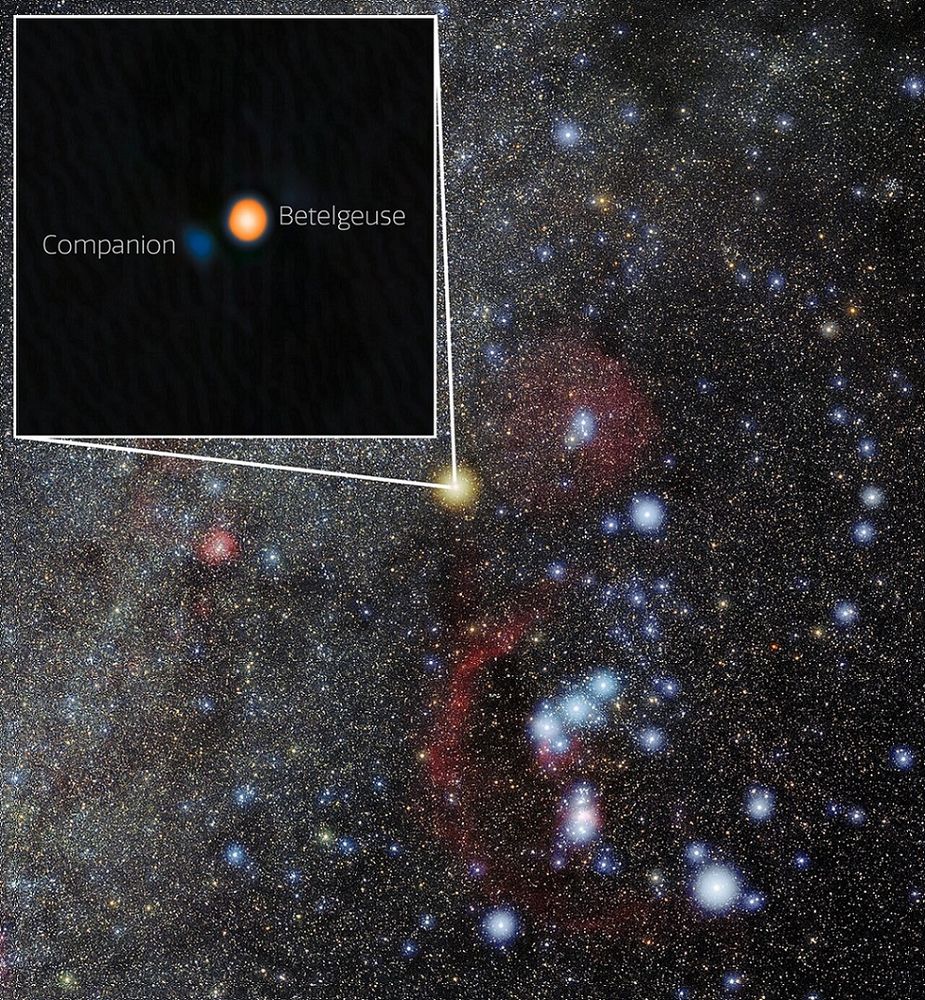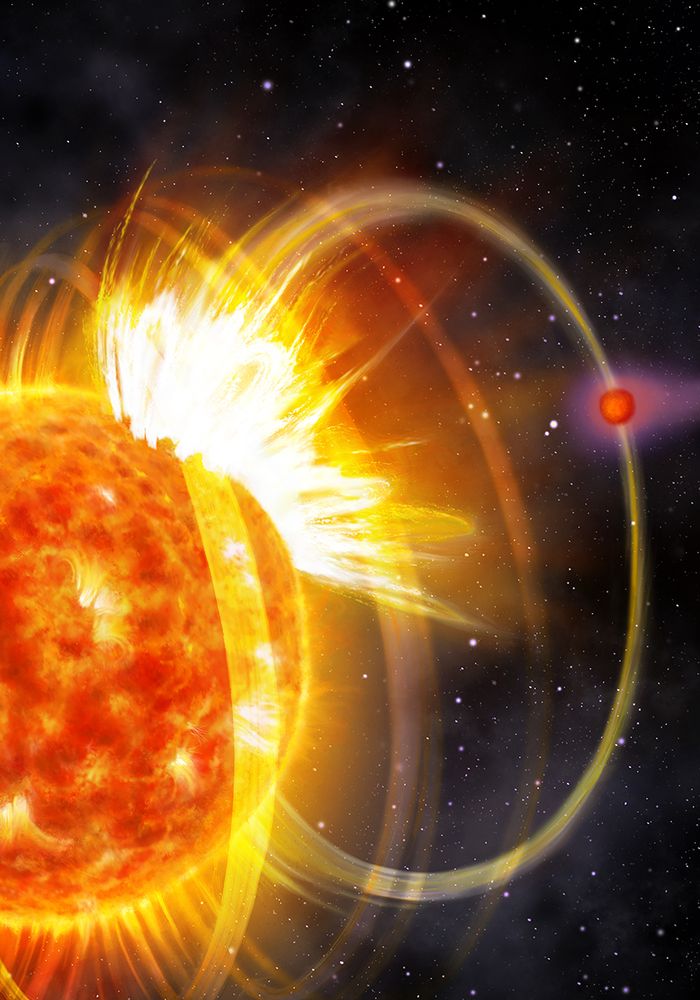
PhD research topics - Anton Pannekoek Institute for Astronomy
PhD research topics
Are you looking to do a PhD in astronomy? Are you interested in radio stars and exoplanets? Then you should apply to do a PhD at @api.uva.nl with me! You can find more about the exciting project below. Applications are due 3rd of November!
api.uva.nl/vacancies/ph...
01.10.2025 06:49 — 👍 23 🔁 12 💬 2 📌 1
Really nice work, congrats!
13.08.2025 14:24 — 👍 0 🔁 0 💬 0 📌 0

The image shows a vast star field with a faint yellow-orange star, Betelgeuse, at its center. Two white segments radiate from it, converging toward a black box at the upper left. In the box, Betelgeuse appears as a bright orange, almost circular disk, next to its companion, a smaller, less well-defined, dark blue star located slightly to the lower left of Betelgeuse. The companion, detected with the 'Alopeke instrument on the Gemini North telescope, is a hot, young star. This discovery explains Betelgeuse's brightness variability every six years.
A 🧵
For centuries, Betelgeuse, the iconic red supergiant in Orion, has fascinated astronomers with its changing brightness.
Why does its light vary over a ~6-year cycle?
Thanks to the Gemini North telescope, we now have an answer: Betelgeuse has a companion star!
🔭 🧪 #stellarastro #galactic
24.07.2025 14:15 — 👍 131 🔁 38 💬 3 📌 1

Reset the counter!
03.07.2025 19:13 — 👍 99 🔁 22 💬 2 📌 2

A bright, fiery, orange-yellow star with swooping magnetic field lines, releasing an intense flare of light into space. To the right of the star, there is a small red planet touching one of the star's magnetic field lines. The flare is blasting in the direction of the planet. A haze of gas around the planet seems to be being pushed out into space. The background is filled with stars, giving the impression of deep space.
🆕For the first time, astronomers using our Cheops mission have caught a planet triggering flares of radiation from the star it orbits 🪐💥
These tremendous explosions are blasting away the planet’s wispy atmosphere, causing it to shrink every year.
Find out more 👉 www.esa.int/Science_Expl...
🔭 🧪
02.07.2025 15:11 — 👍 150 🔁 26 💬 3 📌 7
These results make HIP 67522 an archetype for star–planet magnetic interactions in newborn systems — its effects on planetary atmospheres.
More to come! 🛰️
02.07.2025 15:46 — 👍 1 🔁 0 💬 1 📌 0
🪐 Planet self-roast!
Two NEW papers on HIP 67522, a young star with two close-in giants and clear signs of magnetic star–planet interaction. The inner planet triggers flares on its host star, exposing itself to a 6 times higher flaring rate than without interaction. #astronomy #exoplanets
02.07.2025 15:46 — 👍 4 🔁 0 💬 1 📌 0
I'm currectly a postdoc in astronomy, working on star-planet interactions at the Netherlands Institute for Radio Astronomy. I'd like to post about cool paper I read, and work I did.
30.06.2025 11:40 — 👍 0 🔁 0 💬 1 📌 0
yes
30.06.2025 11:38 — 👍 0 🔁 0 💬 1 📌 0
@bot.astronomy.blue
signup
30.06.2025 11:36 — 👍 0 🔁 0 💬 1 📌 0

Stellar flares may hamper search for life in promising star system
Astronomers have been trying to detect atmospheres on planets orbiting TRAPPIST-1, but bursts of radiation from the star make this challenging
Very small flares on a very small star with a bag full of very small planets. Detecting atmospheres on these terrestrial companions keeps challenging astronomers. Great work by Julien de Wit et al.! #trappist-1 #habitability #exoplanets #hubble
www.newscientist.com/article/2485...
30.06.2025 11:36 — 👍 3 🔁 0 💬 0 📌 0
Astronomy postdoc at the Instituto de Astrofísica de Canarias (IAC, Spain). Hunting low mass exoplanets. Member of the ESPRESSO, NIRPS, HARPS-3, ANDES, and CHORUS, science teams. Co-PI of the IACSAT-1.
Exoplanet Astronomy
Assistant Professor
Santiago de Chile
http://gijs.cl
\m/
Astrophysicist and domestic goddess! Any opinions here are just mine and do not necessarily represent those of NASA or Caltech.
PhD, occasional astronomer, talking head, science geek, cynic. Senior Editor at @Science.org, responsible for research papers in astronomy and planetary science. Views own, duh. Bio: https://www.science.org/content/author/keith-t-smith
🇨🇭
• ESO fellow @eso.org exploring exoplanet atmospheres 🪐 🔭 🇩🇪
• PhD from Lund Observatory 🇸🇪 & ESO 🇨🇱
• passionate about all things outreach and science communication ✨
Postdoc researching exoplanet biosignatures, Univ. of Arizona | Astrobiologist | Trans Lesbian | Wife | SFF Writer | Lukewarm Ecosocialist | Union Woman | One Half of @asabpod.bsky.social | She/Her| 🌹
www.tessafisher.com
Words and opinions are my own.
Staff Astronomer @ a place - Exoplanet Atmospheres with JWST. All data is good data.
Plus Knitting, Stickers, Baking, and other crafty things. Toddler mom.
Known as @_astronoMay on other sites
ErinMMay.com
SiderealStickers.Etsy.com
Caltech/IPAC Planet Hunter | Chief Scientist, NASA Exoplanet Science Institute | @TEDFellow | Science consultant | General Nerd | My views are not the views of NASA | She/her
A sprinkling of astrophysics, a dash of personal thoughts, and a lot of dog photos. Lecturer at University College Cork.
PhD student @ Instituto de Astrofísica de Canarias. I look for exoplanets, but I am generally fond of numerical modelling. I tend to post in EN/ES/BG.
Postdoc @univie.ac.at
Researches the Milky Way & star clusters with machine learning
Founded the Astronomy feeds (@astronomy.blue)
🏳️🌈 🏳️⚧️ (she/her), Ⓥ
Website: https://emily.space
GitHub: https://github.com/emilyhunt
Get ready for a new era in astronomy and astrophysics with Rubin Observatory!
Para español siga a Instagram: http://instagram.com/rubin_observatory
Digestible summaries of the latest astronomy research. Written by an international team of grad students for undergrads! Supported by the @AAS_Office. #scicomm
Professor of Astrophysics @ Univ. of Amsterdam. Neutron stars, pulsars, dense matter, X-ray astronomy. Mom, Migrant. "Particles in stars blah blah". Does science with NICER on the International Space Station and schemes for EVEN BIGGER SPACE TELESCOPES.
Professor of astronomy working at Leiden Observatory in the Netherlands on the direct imaging of extrasolar planets and transits of giant ring systems || Opinions my own || Will tell Dad jokes for cash. https://kenworthy.space/
Postdoc at Vanderbilt University working on stellar magnetic activity and its impacts on planetary atmospheres. (He/him/his)
#50YearsOfESA: we're the European Space Agency, keeping you posted on European space activities.
Please see our Privacy Notice: https://esa.int/connectwithus
We're the German Aerospace Center & are passionate about our research in #Energy #Transport #Aeronautics #Digitalisation #Space
dlr.de/en
dlr.de/imprint
Astrophysikalische Grundlagenforschung von der Untersuchung unserer Sonne bis zur Entwicklung des Kosmos.
Webseite: www.aip.de










